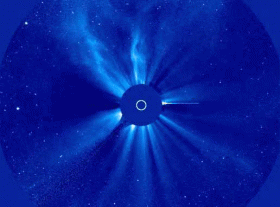Science with the solar space observatory Hinode

The solar space observatory Hinode was launched in September 2006, with the name "Hinode" meaning sunrise in Japanese. The Hinode satellite carries a solar optical telescope (SOT), an X-ray telescope (XRT), and an EUV imaging spectrometer (EIS). Hinode investigates both the interior and the atmospheric regions of the Sun. Its primary objectives are to address the origin of the Sun's magnetic field, the driving force behind solar eruptive events, and the nature of the hot corona.
As recognition of the impact of Hinode on various branches of solar physics, Astronomy & Astrophysics is publishing a special feature this week consisting of 18 Letters that present the new results obtained with Hinode. These papers focus on the physics of sunspots, the emergence of magnetic flux on the solar surface, and the dynamics in the solar corona. Figure 1 illustrates these topics.
A handful of these papers are about sunspots, which are still mysterious in several aspects. They highlight the fine structure of the penumbra, which is the ring of radial structures surrounding the dark core of the spots. They present new evidence that the penumbra consists of sea-serpent-like magnetic flux tubes, embedded in a background wrapped around these tubes and connected to magnetic features outside the spot.
Several papers also study the dynamics of the solar corona, focusing on active solar regions and coronal mass ejections (CME, also known as transient events, illustrated on Fig. 1). The new Hinode observations show that the standard scenario describing solar flares do not fit microflares. The high resolution of the soft X-ray telescope on Hinode will help to distinguish between different scenarios.
The papers published this week in A&A – which illustrate only a small part of the science with the new data – show new directions in solar research facilitated by the new solar space telescope Hinode. Through observations of all atmospheric layers of the Sun, from the photosphere and chromosphere into the corona, data from the Hinode observatory provide new insight into the structure and dynamics of the solar atmosphere, an important step toward a better understanding of stellar atmospheres in general.
The Astronomy & Astrophysics special feature (volume 481 n°1 – April I 2008) on the science with Hinode includes 18 articles. They are freely available on the A&A web site: www.aanda.org/ .
Source: Astronomy & Astrophysics





















